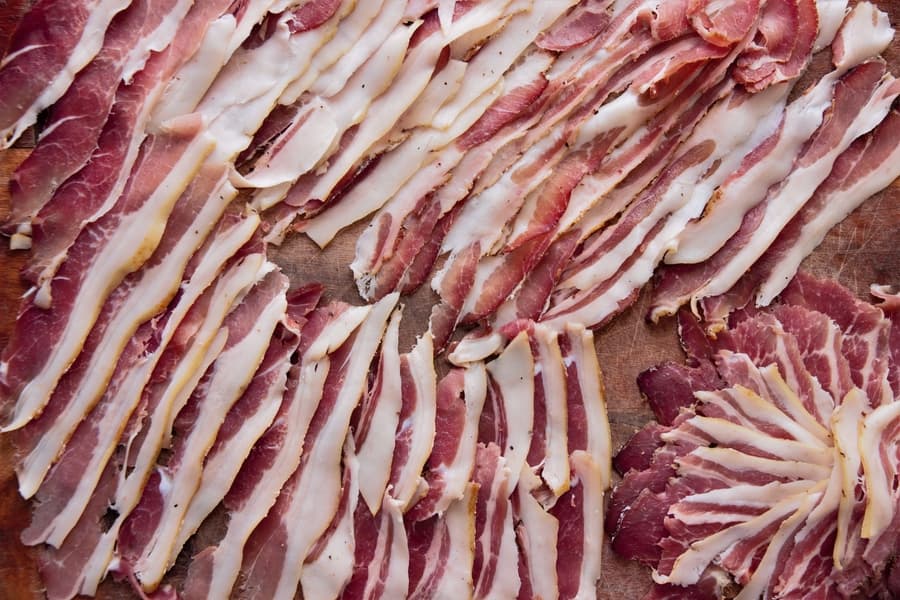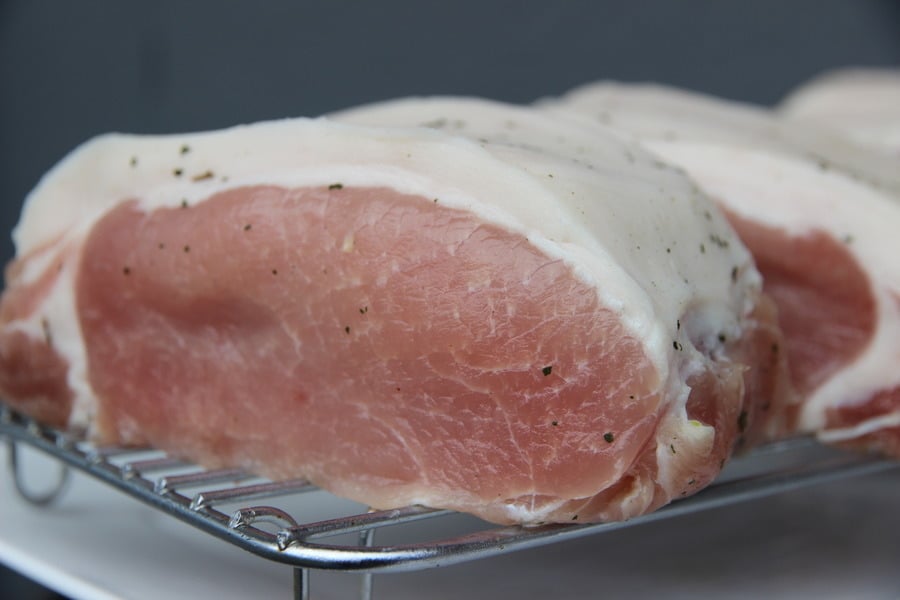I’ve been curing bacon at home for over 20 years, experimenting with every wood, spice, and technique imaginable. Along the way I discovered that using equilibrium curing — whether dry or wet — gives me total control over salt levels and flavor. But here’s the real question:
Which method is right for you? If you want bold, rich flavor and a firmer texture — ideal for cold smoking — a dry cure is hard to beat. On the other hand, if you’re hot smoking bacon (and want extra juiciness), a wet brine can help your meat stay succulent and cook evenly.

Dry Equilibrium Cure vs Wet Equilibrium Brine
| Criteria | Dry Cure | Wet Brine |
|---|---|---|
| Flavor Intensity | Concentrated and robust | Milder, more even spice infusion |
| Spice Profile | Bold—spices cling to surface | Subtle—spices dilute through brine |
| Texture | Possible, but harder to dry | softer texture |
| Cold Smoking | Ideal | Possible but harder to dry |
| Hot Smoking | Better | |
| Time | Faster — no dilution step | Slower —time to dissolve & submerge |
Both techniques have their place — I regularly use each depending on how I plan to finish the bacon. For cold smoking, dry curing gives me a firm, dry surface that absorbs smoke beautifully. For hot smoking, wet brining delivers juicier slices that hold up to a warm cook.
Let’s take a closer look at how equilibrium dry curing works, including how I measure, apply, and adjust each recipe to suit different cuts and spice blends.
Equilibrium Curing Bacon
Equilibrium dry curing uses precise salt and spice ratios based on the weight of your meat—no covering it in salt and hoping for the best. You’ll need a reliable digital scale (0.01–0.1 g precision) and a spice grinder for even mixing.
1. Calculate Your Cure
Decide your target salt level (usually 2–2.5% total, including 0.25% pink curing salt). Weigh your meat, then use my equilibrium curing calculator to work out exact gram amounts for salt and spices (it also calculates wet brine curing).
2. Weigh & Grind Ingredients
- Weigh each ingredient separately on your scale.
- Grind salt first, then spices, to a fine powder.
- Combine & blitz briefly in grinder for uniform texture.
3. Mix & Apply Cure
Place the pork belly in a large bowl. Sprinkle the cure evenly, then use the meat itself to sweep the bowl clean—this ensures no cure is wasted.
4. Package & Refrigerate
Roll the meat in a Zip‑Lok bag, squeeze out as much air as possible (vacuum seal optional), then refrigerate. I press the bag under fridge shelf cans for even contact.
5. Cure Time
Cure for 5–9 days per kilogram of meat (longer if spices are coarse). Once complete, rinse lightly or gently brush off excess herbs if desired.
6. Cold-Smoke & Store
Pat the meat dry (pellicle should form), then cold‑smoke for 8–20 hours. Store in the fridge for up to 2 weeks or freeze for longer keeping.
Pro Tips:
- Use a scale with at least two decimal places when measuring small amounts of salt or spice.
- Grind pink curing salt and spices separately, then blend for consistent curing.
- Remove air from packaging to improve cure penetration—Vac‑Pac or Zip‑Lok both work well.
Equilibrium Brining Bacon
Equilibrium brining is similar to dry curing, but the salt and spices are dissolved in water to form a liquid cure. This is especially helpful if you’re hot-smoking your bacon, because it helps the meat retain moisture through the cooking process.
I’ve used this method when I want softer, juicier bacon or when I’m working with larger slabs that benefit from a soaking cure. It’s not quite as intense in flavor as dry curing, but still produces a beautifully balanced and seasoned result.
1. Calculate Your Brine
Weigh your meat and multiply by 40% to determine the amount of water to use. Then calculate your cure ingredients based on the combined weight of the meat and water.
Use my meat curing calculator to make this quick and precise.
For example, if you’re curing 1,000 g of pork belly:
| Ingredient | Amount (Grams) |
|---|---|
| Meat | 1,000 g |
| Water (40%) | 400 g (or 400 mL) |
| Sea Salt (2.0%) | 28 g |
| Pink Curing Salt (0.25%) | 3.5 g |
| Spices (optional) | to taste |
2. Mix the Brine Solution
Grind your salt and spice mix into a fine powder before adding to lukewarm water. Stir until everything is fully dissolved. You should see no particles floating—just a clear, seasoned brine.
3. Submerge the Meat
Place your pork belly in a container just big enough to fit the meat and brine. If needed, use a weight to keep the meat fully submerged.
Make sure the container is food-safe and fits in your fridge. You can also use a large reusable vacuum bag or silicone sous vide bag if you’re trying to cut down on plastic use (I’ve been experimenting with both).
Tip – I’ve had success injecting the cure consistently into the meat with a injection basting type syringe needle, this has halved the curing time.
4. Cure Time
I usually brine for 6–10 days, depending on meat thickness and salt level. Thinner belly slabs may be ready in 5–7 days. Stir or agitate the container halfway through to ensure even salt distribution.
5. Remove & Pat Dry
Take the meat out of the brine and pat it dry. You can rinse it lightly, but I often leave on some of the aromatic flavors. Let it air-dry in the fridge overnight to form a pellicle before smoking.
For more tips on prepping pork belly before smoking, check out my post on whether to leave the skin on or off your homemade bacon.
From here, you’re ready to hot or cold smoke depending on your style—I’ll share some tips for that next.
Smoking Bacon After Equilibrium Curing or Brining
Once your bacon has been equilibrium cured—either dry or wet—you’ve got a few options for how to finish it. Each method produces different textures and flavors depending on how it was cured.
- Green Bacon – no smoke, just cured and dried
- Hot Smoking – smoked while being cooked
- Cold Smoking – smoked without heat, low and slow
Green Bacon (Unsmoked)
Sometimes I skip the smoke entirely and just dry the bacon in the curing chamber or fridge. This is what I call “green bacon.” It has a clean, savory cured flavor and works great diced into soups or pasta.

Hot Smoking
Hot smoking cooks the meat as it smokes—ideal if you want ready-to-eat bacon straight off the smoker. I find that wet-brined bacon holds moisture better in this method and comes out juicy even after pan-frying later.
I tend to smoke at 90–100°C (195–210°F) until the internal temp hits about 65–68°C (150–155°F). After cooling, I refrigerate or vacuum seal for storage. The texture is softer than cold-smoked bacon, and there’s no drying time needed afterward.

Cold Smoking
Cold smoking is where dry equilibrium curing really shines. Because the meat isn’t being cooked, it benefits from the firmer texture and drier surface you get with a dry cure. I cold smoke bacon in multiple short sessions—usually 6 to 20 hours total.
Dry-cured slabs develop a pellicle quickly in the fridge, making them perfect for absorbing just the right amount of smoke. I aim for a subtle aroma, not overpowering smoke. Think airflow, humidity, and patience.

Which Method Works Best?
Personal preference works best; it’s your choice.
For me, If I’m making hot-smoked bacon, I typically use a wet brine. It helps retain moisture and gives the meat a gentler cure. For cold smoking or long drying, I stick with dry curing. The flavors come through stronger and the texture is ideal for slicing thin.
You can experiment with both methods and see what matches your style of cooking—or how you like to eat your bacon. I enjoy swapping between them based on the time of year, the cut of pork, or just for variety.
Advantages and Challenges of Each Method
Advantages of Equilibrium Dry Curing
- Bold, concentrated flavor that develops with cold smoking
- Shorter curing time compared to brining
- Works well for thin slabs of pork belly
Challenges of Equilibrium Dry Curing
- Requires precise digital scales and grinding for accuracy
Advantages of Equilibrium Wet Brining
- Helps retain moisture when cooking hot smoked bacon
- Even salt and spice distribution across large cuts
- Can scale up for multiple pieces or large batches
Challenges of Wet Brining
- Longer total time due to dilution and curing phase
- Requires more fridge space (or cool area) and a suitable container (weighed down under water surface also)
Can I cold smoke after wet brining?
Yes, but make sure the meat is well dried first. Wet-brined bacon retains more surface moisture and takes longer to form a pellicle. Air-dry in the fridge for at least 24 hours before cold smoking.
What’s the ideal salt percentage for bacon curing?
A common target is 2–2.5% total salt, including 0.25% pink curing salt. This gives a balanced flavor without over-salting. Use a digital scale and curing calculator for best results.
Do I need to rinse bacon after curing?
Rinsing is optional. I usually pat the meat dry and only rinse if there’s excess spice. Some people leave the cure on for a stronger flavor during smoking.
Can I add sugar to the cure?
Yes, you can add up to 1% sugar by weight for a sweeter finish. This complements pork and helps caramelize during hot smoking.
If you’re cold smoking and want strong cured flavor, dry curing is hard to beat. If you’re hot smoking or want hot smoked bacon, wet brining gives better outcomes in my opinion. I often switch between both depending on the cut, my spice blend, and the end use.
The most important thing is to get the salt ratios right and work by weight, not volume. With accurate scales and a good curing container or bag, you’ll get great results batch after batch.

Tom Mueller
For decades, immersed in studying, working, learning, and teaching the craft of meat curing, sharing the passion and showcasing the world of charcuterie and smoked meat. Read More
